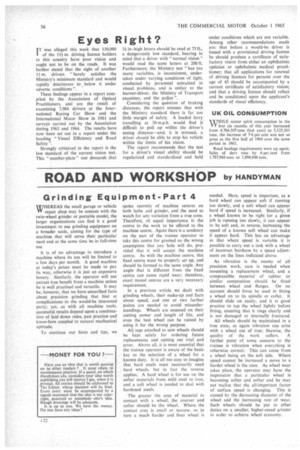ROAD AND WORKSHOP by HANDYMAN
Page 58

If you've noticed an error in this article please click here to report it so we can fix it.
Grinding Equipment-Part 4
WHEREAS the small garage or vehicle VV repair shop may be content with the twin-wheel grinder or portable model, the larger organizations can find it a good investment to use grinding equipment on a broader scale, aiming for the type of machine that will serve their particular need and at the same time be in full-time Use.
It is of no advantage to introduce a machine where its use will be limited to a few days per month. A good machine at today's prices must be made to pay its way, otherwise it is just an expensive luxury. Similarly, the operator will not extract true .benefit from a machine unless he is well practised and versatile. It may be, however, that we have unearthed facts about precision grinding that hint at complications to the would-be interested party: yet, as with all machine tools, successful results depend upon a combination of laid down rules, past practice and know-how coupled to natural mechanical aptitude.
To continue our hints and tips, we
spoke recently of machine centres on both lathe and grinder, and the need to watch for any variation from a true cone. Therefore, of equal importance is the centre in the work to be offered to the machine centre. Again there is a tendency on the part of the trainee operator to take this centre for granted on the wrong assumption that any hole will do, provided that it will accept the machine centre. As with the machine centre, this fixed centre must be properly set up, and should be formed to the same angle. Any anglethat is different from the fixed centre can cause rapid wear; therefore, exact mated centres are a very necessary requirement.
In a previous article we dealt with grinding wheels, their make-up and facts about speed, and one or two further points are needed to avoid misunderstandings. Wheels are assessed on their cutting power and length of life, and even the best wheel can be ruined by using it for the wrong purpose.
All tags attached to new wheels should be kept safely for ordering future replacements and cutting out trial and error. Above all, it is most essential that the trainee operator is aware of the basic key to the selection of a wheel for a known duty. It is all too easy to imagine that hard steels must necessarily need hard wheels, but in fact the reverse applies. A hard wheel is for use on the softer materials from mild steel to iron. and a soft wheel is needed to deal with hardened steels.
The greater the area of material in contact with a wheel, the coarser and softer should be the wheel. Where the contact area is small or narrow, so in turn a much harder and finer wheel is
needed. Here, speed is important, as a hard wheel can appear soft if running too slowly, and a soft wheel can appear hard if speed is increased. Similarly, if a wheel known to be right for a given job is running too slowly, it can appear to he soft and, in reverse, increasing the speed of a known soft wheel can make it appear hard. This has an advantage in that where speed is variable it is possible to carry out a task with a wheel of incorrect hardness by a speed adjustment on the lines indicated above.
As vibration is the enemy of all precision work, care is needed when mounting a replacement wheel, and a compressible material of rubber or similar composition should be fitted between wheel and flanges. On no account should force be used in fitting a wheel on to its spindle or collet. It should slide on easily, and it is good practice to tap the wheel lightly before fitting, ensuring that it rings clearly and is not damaged or internally fractured.
All wheels should be maintained in a true state, as again vibration can arise with a wheel out of true; likewise, the quality of the work suffers. A further point of some concern to the trainee is vibration when everything is otherwise correct.This can come from a wheel being on the soft side. Where speed cannot be increased a move to a harder wheel is the cure. As wheel wear takes place, the operator may have the impression that a particular wheel is becoming softer and softer and be may not realize that the all-important factor of surface speed is changing. This is caused by the decreasing diameter of the wheel and the increasing rate of wear. Such wheels should be put to other duties on a smaller, higher-speed grinder in order to achieve wheel economy.












































































































































































